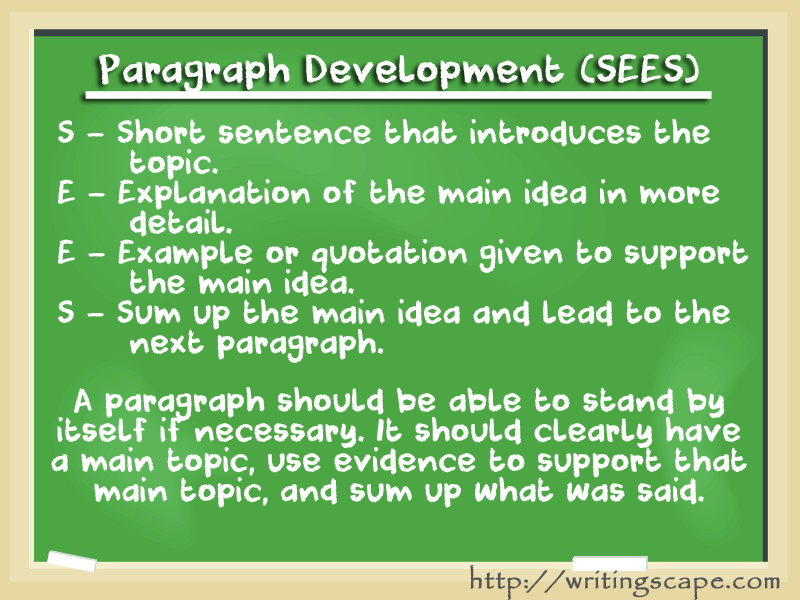Many people struggle with writing a complete, unified, and coherent paragraph, no matter what purpose that paragraph serves. In order to be complete, a paragraph has three necessary parts: the topic sentence, the body, and the concluding sentence.
These parts are vital because they help the paragraph have a start, a middle, and an end – all important components in any activity, including writing paragraphs.
- The topic sentence – States the main point. The topic sentence is often the first sentence of the paragraph.
- The body – Supports (shows, explains, or proves) the main point with support sentences that contain facts and details.
- The concluding sentence – Reminds readers of the main point and often makes an observation.
While this is generally a good guideline to go by, I suggest a little more detail when giving my students guideline on writing paragraphs. Specifically, when I provide information to my students on how to write paragraphs, I suggest they use the “SEES” method of paragraph development, as outlined in this image:

In the SEES method of paragraph construction, the first part is going to be the topic sentence – a short sentence that introduces the topic of the paragraph. The second part will be an explanation of the main idea with more detail, illustrating what that topic is or what that point is. The third part of the paragraph is all about evidence – such as an example, a summary or paraphrase from a source, or a direct quote from a source that is going to give support to the main point of the paragraph. The final part of the paragraph is a summary or concluding sentence – this sums up what was said. It shouldn’t contain new information or new evidence. It is only summarizing what has already said in order to help the reader digest that information and move on to the next paragraph.
After you write a paragraph, I think it helps to go through and identify the parts of that paragraph for your own reference so you know that it contains what you need it to contain. For example:
[S] Plagiarism is a problem because it damages the credibility of schools. [E] When students engage in plagiarism, they aren’t learning from the program or courses they are taking and are instead presenting other people’s information as their own, which negatively affects their ability to learn this information for themselves. As the goal of a school is to “teach” students the information, plagiarism is an indication of failure on the school’s part. [E] As Michael Fleming of Norton Publishing says in his online article “Academic Honesty and Avoiding Plagiarism: A Self-Guided Tutorial,” “Plagiarism erodes the intellectual integrity that is the bedrock of academia” (2008, para. 3). Fleming continues, “Plagiarism creates an atmosphere of doubt–doubt that students are really learning, doubt that grades and degrees are meaningful, doubt that teachers are really doing their job.” Essentially, Fleming is saying that plagiarism takes away the value of an education. [S] With this in mind, schools need to identify ways to curb or prevent plagiarism in order to encourage student learning and improve the school’s integrity.
Here, the topic is about plagiarism damaging school credibility. The next section expands on what this means. Next we see evidence from a credible source that supports this point. Finally, we have a concluding sentence that sums up what was said, but also helps to lead to a new paragraph, which could be about ways that students curb or prevent plagiarism.
By following this type of formula in writing paragraphs, the writer can ensure that they are clearly unifying around a specific topic, staying coherent in terms of the topic, and providing support for the argument or point being made.